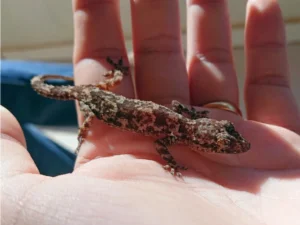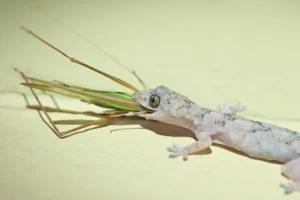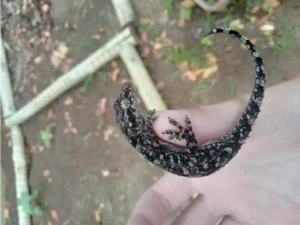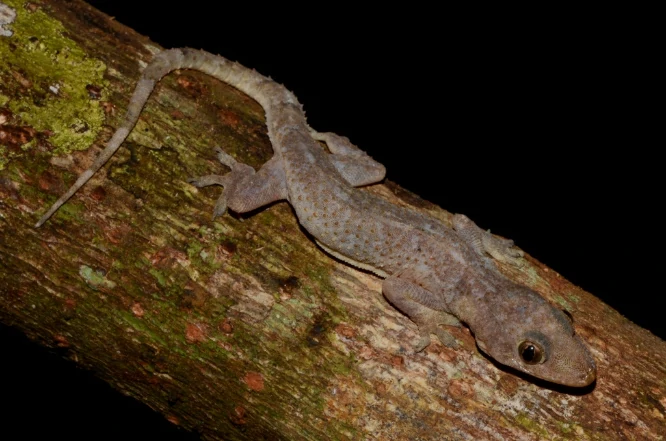If you’ve ever seen a tiny house gecko scurry across your wall at night, you might have wondered what it’s like to have one as a pet. They’re small, quiet, and don’t seem like they’d cause any trouble. But what’s it really like taking care of them? Are house geckos easy to take care of?
Yes, House geckos are fairly easy to take care of once their basic needs are met. They don’t need constant handling or attention, and they’re generally hardy little reptiles. As long as you give them the right tank setup, temperature, humidity, and food, they’ll usually do just fine in captivity.
Even though they’re low-maintenance compared to other reptiles, you can’t just throw them in any container and forget about them. Their home setup is really the key to keeping them healthy and happy.
What Makes House Geckos So Easy to Care For?
One of the main reasons people like keeping house geckos is that they’re naturally tough. They live in all kinds of places, from humid jungles to dry city walls.
They’ve learned to live around humans, so they’re not as fragile or picky as some other reptiles.

They don’t need fancy lights or huge tanks. Most adult house geckos are happy in a medium-sized tank, around 10 to 20 gallons for one or two geckos. They also don’t need weird or expensive food.
They mostly eat insects, so crickets, small roaches, or mealworms a few times a week is enough. You don’t have to hunt for anything fancy, most pet shops sell everything they need.
Since they’re nocturnal, they’re most active at night, so you don’t need bright UVB lights like other reptiles. Just a simple heat source to keep the tank warm usually works fine.
Setting Up a Home for Your Gecko
If you’re thinking about getting a house gecko, the most important thing is their home. They’re small, but they need space to climb, hide, and explore.
A 10-gallon vertical tank is fine for one gecko, but if you want more than one, go bigger. Geckos are territorial, and even if they look calm, they can fight if they don’t have enough space.
Inside the tank, give them things to climb on: branches, plants (real or fake), and hiding spots. They love vertical space more than floor space, so tall decorations are great. Think of it like building a mini jungle gym for them.
Humidity matters too. House geckos come from warm, humid places, so mist the tank lightly once or twice a day. This keeps their skin healthy and helps them shed properly.
You don’t want it soaking wet, just a little moist.
They like the temperature between about 77 to 90°F (25–32°C). A small heat lamp or heat mat usually works. Just don’t let it get too cold at night. A thermometer and hygrometer help you keep things steady.
Feeding House Geckos the Right Way
Feeding house geckos is easy, but a few things help. They only eat insects. Crickets, small roaches, or mealworms (or a mix of all three) works fine.

Dust the insects with calcium and vitamin D3 once or twice a week. This helps their bones stay strong and keeps them healthy.
They like hunting live prey, so watching them stalk and snap at crickets can actually be fun. Just make sure to remove leftover insects after feeding, because crickets can bite or stress them if left in the tank.
For water, they usually drink droplets off glass or leaves after misting, but you can leave a shallow dish in the tank just in case.
Do You Need to Handle Them Often?
Not really. House geckos are best watched rather than held. They’re fast, get stressed easily, and can drop their tails if scared. The tails grow back, but it’s stressful for them.
If you need to move one, like to clean the tank, be gentle. Guide it into a small container instead of grabbing it. Some geckos might get used to people over time, but most don’t like being picked up.
It’s not that they’re mean, they just like their space. If you want a pet you can hold all the time, a house gecko might not be for you.
But if you like quietly watching them explore and hunt, they’re perfect.
Common Mistakes New Owners Make
Even though house geckos are tough, beginners can make mistakes that cause problems. The most common ones are:
-
Using the wrong substrate: Avoid sand or gravel. If swallowed, it can block their digestive system. Coconut fiber, paper towels, or reptile bark works better.
-
Keeping the tank too dry: Low humidity makes shedding hard. Mist lightly every day and have hiding spots that stay a bit moist.
-
Overfeeding or underfeeding: Give small portions regularly instead of dumping a ton of insects at once. Overfed geckos can get sluggish.
-
Too much handling: They get stressed if you handle them too often.
-
Not enough hiding spots: Without places to hide, they feel unsafe, get anxious, or stop eating.
Fixing these usually helps them bounce back quickly. They’re tough little lizards, so even if you mess up at first, they usually recover once things improve.
Can You Keep More Than One in the Same Tank?
It depends. You can keep one male with one or two females, but never put two males together. Males are territorial and will fight, sometimes badly.

If you keep a pair or a small group, make sure the tank is big enough and has several hiding areas. Each gecko needs its own space.
Watch for bullying (one gecko hiding all the time, losing weight, or missing parts of its tail) and separate them if needed.
If males and females are together, breeding can happen easily. Be ready for baby geckos. Females lay small, sticky eggs that can hide under bark or leaves.
How Long Do House Geckos Live?
In the wild, house geckos live about 5 years on average, sometimes less because of predators or tough conditions.
In captivity, where they’re safe and fed, they can live up to 8 or 10 years.
How long they live mostly depends on care, steady temperature, the right food, and a clean tank make a big difference. Even though they’re small, they can live a long time if you set things up right.
How to Keep Their Tank Clean and Healthy
A clean tank keeps your gecko healthy. It doesn’t take long, but you should do it regularly.
Remove leftover insects after feeding, wipe the glass if it’s wet or dirty, and replace soiled substrate every week or two. Do a deeper clean (change all the substrate and clean decorations) about once a month.
Avoid strong chemicals or cleaners that smell a lot. Just use warm water and a reptile-safe cleaner. Geckos breathe through their skin, so leftover residue can bother them.
Can Kids Take Care of House Geckos?
With adult help, yes. House geckos are quiet, small, and easy to feed. They can be a good “first reptile” for families wanting something low-maintenance.

Kids just need to learn not to handle them roughly. Geckos can drop their tails if scared, which can upset children. It’s best to let kids watch and feed them, but not hold them.
Parents should help with cleaning and feeding at first. Once it’s routine, care is easy.
Are House Geckos Friendly?
They’re not affectionate like a dog or cat, but that’s normal for reptiles. Over time, some geckos stop hiding when you’re near the tank. They might even come out when they see movement.
That’s as “friendly” as they get; calm, curious, and not bothered by you. You enjoy watching them rather than holding them.
What About Health Problems?
House geckos don’t get sick often if you care for them properly, but a few things can happen.
If your gecko loses weight, acts slow, or refuses food, check the temperature and humidity first. Most problems happen when those are off.
Shedding issues (old skin stuck on toes or tail tips) usually happen if it’s too dry. Mist more or provide a moist hiding spot.
If your gecko seems weak or its jaw feels soft, it might need more calcium. That’s why dusting food is so important.
Also, buy geckos from a trusted source. Wild-caught ones sometimes carry parasites or infections, while captive-bred ones are usually healthier and easier to tame.
Conclusion
So, are house geckos easy to take care of? Pretty much, yes. They’re one of the easiest reptiles if you get the basics right; warmth, humidity, good food, and some space to climb.
They don’t take up much room, they’re quiet, and they rarely cause problems. You don’t have to handle them much, and they’re fun to watch at night as they hunt and explore.
If you want a low-maintenance pet that’s still interesting, house geckos are a great choice. Sometimes the simplest pets (the ones hiding on your walls) are the most rewarding.
Hi, my name is Ezra Mushala, i have been interested animals all my life. I am the main author and editor here at snakeinformer.com.

